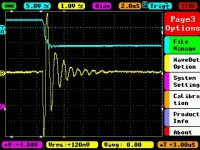You can build a bellringer test jig on your protoboard which will let you visually dial in the optimum value of the snubber. Search the forums for "bellringer" and/or "Quasimodo" -- you will find that the thread NAME is No-Math Snubbers which sounds well-suited to your preferences.
The article I like best is the one in Linear Audio magazine. Its takeaway was
48 different diodes were tested, including Schottkys, HexFreds, SoftRecovery, Silicon Carbide, you name it.BTW the worst performing diode was a 35 amp, 1000 volt, silicon bridge rectifier. Part number GBPC3510. sales link
The very best performing diode, without a snubber, was not as good as the very worst performing diode plus a snubber
Bought the Johnson (and Jones) articles today. Have the Quasimodo. Been using GBPC3504 rectifiers in my builds. Look forward to some fun experiments and listening.
BK
Warning: I bought the cheapest "oscilloscope" in the world ($16) and tried it with a transformer + Quasimodo. No worky. Its bandwidth (claimed 200 kHz) was too low and its triggering was too stupid, to properly display the transformer ringing. However I did also try the phony baloney experiment of increasing the DeviceUnderTest's inductance by a factor of ten thousand times, which reduced the oscillation frequency by sqrt(10000) = 100 times. Then: whoop dee doo, the little toy scope was able to display the waveforms. Here is my report.Even better, you can get into the game for under a Benjamin (cheapomodo kit + inexpensive oscilloscope) and a little reading.
If anyone is contemplating purchasing their first oscilloscope, just to use with Quasimodo, please don't buy anything with less than 5 to 10 MHz bandwidth. Me, I bought a battery powered, self contained (non-USB) scope just this week, and I paid $135 for 2 channels & 20 MHz bandwidth. This will be my fourth scope; my others have 300 & 400 MHz bandwidth, but they're not battery powered / handheld.
Warning: I bought the cheapest "oscilloscope" in the world ($16) and tried it with a transformer + Quasimodo. No worky. Its bandwidth (claimed 200 kHz) was too low and its triggering was too stupid, to properly display the transformer ringing. However I did also try the phony baloney experiment of increasing the DeviceUnderTest's inductance by a factor of ten thousand times, which reduced the oscillation frequency by sqrt(10000) = 100 times. Then: whoop dee doo, the little toy scope was able to display the waveforms. Here is my report.
If anyone is contemplating purchasing their first oscilloscope, just to use with Quasimodo, please don't buy anything with less than 5 to 10 MHz bandwidth. Me, I bought a battery powered, self contained (non-USB) scope just this week, and I paid $135 for 2 channels & 20 MHz bandwidth. This will be my fourth scope; my others have 300 & 400 MHz bandwidth, but they're not battery powered / handheld.
I used this one:
https://www.sainsmart.com/dev-boards/fpga-cpld/sainsmart-dso-note-ii-oscilloscope.html
Only 1MHz analog but has 2 channels for $80.
Attachments
Me, I bought a battery powered, self contained (non-USB) scope just this week, and I paid $135 for 2 channels & 20 MHz bandwidth. This will be my fourth scope; my others have 300 & 400 MHz bandwidth, but they're not battery powered / handheld.
I've been thinking of buying a scopemeter too, I already have bench units.
I suspect the battery powered hand held units have a lower noise floor which would be useful.
Bought the Johnson (and Jones) articles today. Have the Quasimodo. Been using GBPC3504 rectifiers in my builds. Look forward to some fun experiments and listening.
BK
Great! Please post your impressions results.. when you have some
Since this thread appears in the Pass Labs forum, and since the title of the thread is "Bridge Rectifier vs. Schottky Diodes for F4", I took a quick look at the owner's manual of the F4 amplifier designed by Nelson Pass. You can too, it is here: link. Page 12 contains the Specifications, and includes a line item:
You will need some very VERY large batteries to supply this amount of power.
- Power consumption: 180 watts
Hi Mark,BTW the worst performing diode was a 35 amp, 1000 volt, silicon bridge rectifier. Part number GBPC3510. sales link
Would you have a good alternative for GBPC3510 bridge?
Thanks.
- Status
- This old topic is closed. If you want to reopen this topic, contact a moderator using the "Report Post" button.
- Home
- Amplifiers
- Pass Labs
- Bridge Rectifier vs. Schottky Diodes for F4
